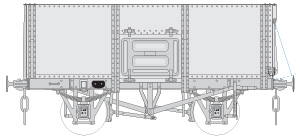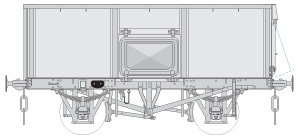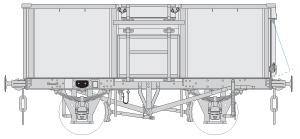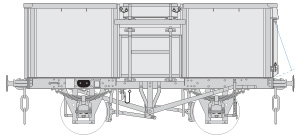Steel Mineral Railway Wagons
LMS & LNER Designs
Scale Drawings for Models
This page describes the scale drawings I have available for you to produce models of all-metal railway wagons that were used to carry minerals such as coal for the commercial customers of the railway companies. The wagons on this page were designed and built by the LMS and LNER after World War II. Many of the LMS wagons weren't delivered until after nationalisation. Similar wagons for other periods are covered by separate pages. This page covers those wagons with the traditional rectangular body shape, similar wagons with wooden bodies, and hopper wagons, will also be covered by separate pages.
Skip to the drawing selection section, but please read through the following Drawings section at least once to understand what you are buying.
LMS D2109 wagon, LMS livery.
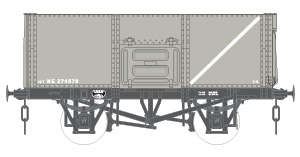
LNER d188 wagon, LNER livery.
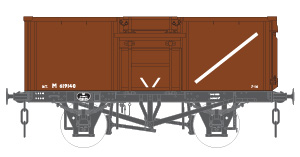
LMS D2134 wagon, hybrid LMS/BR livery.
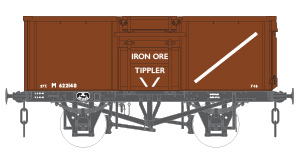
LMS D2153 wagon, hybrid LMS/BR livery.
Note: Clicking on any of the images on this page, such as those above, will cause a larger version of the image to appear in a new tab or window of your browser (depending on how your browser is set up).
The Drawings
As with all of my standard drawings, each drawing is available in a range of scales, from 2mm:1ft (N gauge) to 16mm:1ft, and most common scales in between. Once you have bought a particular drawing, you will be able to download versions of it in any or all of the available scales. At extra cost I can also provide copies of drawings at a specific scale printed onto A3 or A4 paper and sent to you by post.
The drawings will be provided as multi-page PDF files, one file for each scale. The first page in the file contains the full drawing, arranged for on-screen viewing. The remaining pages each contain a portion of the full drawing formatted for printing out on A4 or A3 paper. A drawing will consist of a number of views each showing an aspect of the wagon, such as a side, end or plan view. Where a view at a particular scale is too large to fit on A4 paper, overlapping pages are provided for you to join together after printing. Alternative pages are also provided for printing onto A3 paper.
To help with this, alignment guides are provided. These take the form of simple fine-lined crosses positioned on either side of the drawing view where I suggest a join be made – typically at a position where a minimum of fine drawing detail crossed the joint. Select one of the overlapping pages and cut it through the drawing along the guides. Carefully position the cut edge on top of the other page such that the crosses are reformed acros the joint. When you're happy with the alignment, tack the pages together with small pieces of transparent sticky tape (e.g. in the vicinity of the guides). Then use a long piece of sticky tape along the whole joint to properly join the pages together. Turn the joined pages over and add a further length of tape on the back.
For the drawings in the smaller scales (4mm and smaller), I've imposed a minimum line width (of around 0.1mm) so that the drawing remains printable. This unfortunately means that fine details amy become obscured or illegible. I suggest that you use a larger scale drawing to examine the details, and use a drawing at the scale you're working to easily transfer dimensions, or even cut up to use as templates.
The drawings for the wagons listed on this page typically contain a side view (both sides are assumed to be identical, apart from being mirror images because of the single end door), a view of each end, longitudinal and transverse cross-section views to show the interior of the wagon, and plan views of the wagon from above, as a cross-section around half-way down the body, and a plan view of the underframe on its own. Where there are major variations for a design, such as using welded or riveted construction for the underframe, two complete sets of views are provided. More minor variations, such as pressed or fabricated doors, are documented by appropriate partial views. There are also often partial views of specific details that are obscured by other features in the standard views.
As well as these views showing the construction of the wagon, I also provide drawings of the wagon in each of the major livery styles it received during its lifetime. The illustrations above are a selection of these livery drawings, reduced in size for on-screen viewing. The illustrations below, alongside side each available wagon type, are also selected views from the corresponding drawings, again reduced in size for on-screen viewing.
To produce these drawings, where possible I've started with an official general arrangement (GA) drawing, if not of the wagon type being drawn, then of a very similar type. From there I incorporate details from other drawings and photographs to produce a fully detailed drawing. Source drawings are often distorted or illegible in places, so unfortunately I can't claim 100% accuracy for my drawings. They should however be very close, and models built to them should look the part and require detailed examination and expert knowledge to detect any errors. A brief description of its origins are included on each drawing, so you can assess the likely accuracy for yourself.
How To Order
A single drawing costs £7.50. Additional drawings ordered at the same time cost £5.00 each. Ordering all drawings on this page as a group will cost £18.00.
Click on the buttons below to add the drawings you want to purchase to your basket. Once you have completed your payment, be sure to return to this site to receive a set of access codes for your purchases – one for each drawing and/or one for the group. These will also be sent to you by e-mail.
Enter these codes on the drawings download page here to be presented with links that you can use to view the drawing files you have purchased, and/or download them to your computer. To make downloading drawings for several scales easier, a combined "ZIP" file is also provided that contains all of the scale files for a particular drawing. Most file viewing apps (Explorer on Windows, or Finder on Mac) provide facilities for unpacking the ZIP file to access the individual files.
To order copies of these drawings printed onto paper, please first purchase the downloadable versions, as above. Then please contact me to request a quote for the printed versions, specifiying which scale(s) you want printed, and whether on A4 or A3 paper. The basic price is £1.00 per sheet of A4, or £1.50 per sheet of A3, plus postage which will also depend on the number and size of sheets required. For these drawings, the smaller scales can be fully printed on a single sheet of A4, while the largest scales can need over 20 sheets. A few sheets of A4 can be folded to fit in a C5 envelope to qualify for the normal letter postage rate. Many sheets of A4 are likely to make a C5 envelope too thick for this and require the large letter rate, so may as well be sent unfolded in a C4 envelope. A3 sheets will always be folded to fit either a C4 or C5 envelope. If you need only a few sheets of A4 and would prefer them to be sent unfolded, please specify this when you request the quote.
Copyright
My drawings are subject to copyright, and are licensed for your personal use only. You are not permitted to modify the files in any way, nor supply copies of them to anyone else, other than to get them printed by a third party. The only exception to this is where you are buying the drawings for a small group of modellers (such as a model railway club) working on a single project.
History
Shortly after World War II the Ministry of Transport (formerly Ministry of War Transport) authorised the LMS and LNER to produce their own designs of steel-bodied mineral wagons in parallel with its own orders for similar wagons to its own designs. The MoT's designs were very similar to the LMS and LNER designs.
Coal traders in the London area had an agreement with the trade unions that limited the height of wagon sides that their workers had to unload. The LMS, LNER and MoT wagons exceeded this height limit, so extra top flap doors above the side doors were added to the designs for further new production. The earlier LMS and LNER designs, and existing wagons, were not modified, but the later LMS designs incorporated these changes.
Once the railways were nationalised in 1948, British Railways took over control of the railways, and ownership of the pooled wagon fleet, from the MoT. The LNER and early LMS designs were delivered prior to nationalisation, but the later LMS designs weren't actually delivered until after nationalisation.
The LNER and early LMS designs were fitted with pressed steel side and end doors from new. These subsequently proved to be vulnerable to damage, and were later replaced with fabricated versions, of either welded or riveted construction. Doors were often not all replaced at the same time, resulting in a mix of door types on a single wagon. The later LMS designs were built with fabricated doors from new.
All of these wagons were fitted with bottom doors, so were also fitted with independent dual 4-shoe brakes. That is, each brake lever only operated the brake shoes on its side of the wagon. There was no connecting bar or other mechanism to link toperation of the brakes on both sides, because this would foul the opening of the bottom doors.
The LNER and early LMS wagons were finished in the standard LNER grey or LMS bauxite (red-brown) livery current at the time. The later LMS wagons delivered after nationalisation were delivered in a hybrid livery of LMS bauxite but with the new standard BR Gill Sans lettering. When subsequently repainted, all of these wagons received the then standard shade of BR grey.
All of these wagons received LMS or LNER fleet numbers. The LMS wagons delivered after nationalisation were registered as private owner wagons with the various grouping railway companies. Those delivered after nationalisation received the standard "M" prefix for LMS-built wagons to their fleet numbers from new. The remainder received the appropriate "M" or "E" prefix on subsequent repainting. Brief details of fleet numbers are included in each drawing.
Wagon Types
LNER design, diagram d188
16T, rectangular riveted body, pressed side and end doors, no bottom doors.
Produced 1945–6, by various manufacturers.
LMS original design, diagram d2109
16T, rectangular welded body, pressed side and end doors, with bottom doors.
Produced 1946–7, by LMS Derby.
LMS later design, diagram d2134
16T, rectangular welded body, fabricated side and end doors, with bottom doors and top flap side doors.
Produced 1949, by BR Derby.
LMS Iron Ore Tippler, diagram d2153
27, rectangular welded body, fabricated side and end doors, with bottom doors and top flap side doors.
Body identical to d2134, underframe strengthed with larger springs and axleboxes to carry 27T.
Produced 1949, by BR Derby.
All Drawings Group
To add all of the above drawings (including any added later) to your basket as a group, at a discounted price of £18:
Clicking on an image above will open a larger view in a separate browser window/tab.
Clicking on the "Add To Basket" buttons will add that set of drawings to your basket.

